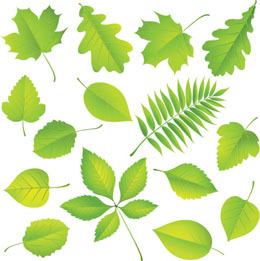To identify various kinds of flora with the help of their leaf characteristics, one has to spend a lot of time in the natural surroundings to carefully observe plant life. This article provides more information on this subject.
 Needle-shaped Leaves
Needle-shaped Leaves: They are mostly seen in evergreen or coniferous forests. The flora from this group include the fir, pine, cypress, spruce, and larch families. The pine trees show clusters of 2 - 5 needles. The larches are deciduous in nature, and their pointed leaves are arranged in clusters with spur-like branches.
The needle-shaped leaves could be single, i.e., one leaf is attached to a single twig as opposed to the cluster form. The firs and spruces show the presence of such leaves. They have 4 sides, and are diamond-shaped in a cross section. These leaves are arranged in a whorl around the twigs, and are attached with wooden pegs known as sterigmata. The firs have leaves that are attached to the twigs by means of bases, which look like suction cups; this makes it possible for easy identification of these flora.
Leaf Position: The leaves could be arranged either on the alternate or opposite sides of the twigs. The leaves of maple, dogwood, and ash varieties are present in this manner.
Simple and Compound Leaves: The simple type of leaves are generally heart-shaped, roundish, or lanceolate in appearance. cottonwood and quaking aspen species have roundish leaves. The leaves of the latter have a pointed tip, and are small with fine teeth. The rattling noise made by leaves when breeze flows is helpful in identifying the tree. The former one has coarser teeth as compared to the latter. The flora with heart-shaped leaves mainly include the catalpa, paulownia, and basswood. The ones with irregular bases and coarse teeth are seen in basswood. The leaves of paulownia are large, and are almost the size of an adult's hand. The leaves of catalpa are similar in appearance to the paulownia type, and they could either be whorled or placed opposite to each other. Examples of trees with lanceolate shaped leaves are: willow, black cherry, and oak. The ones belonging to the willow tree could either be smooth, or have teeth on the edges. Black cherry is characterized by pointed tipped leaves and fine teeth.
Compound leaves could either be pinnate or palmate in their arrangement. The leaflets of the former are aligned at both sides of the stem, while those of the latter type emerge from the stem, ending like spokes of a wheel. Black walnut has pinnate leaves, which are pointed at the tip; a single leaf has 7 - 17 leaflets. Alianthus has 11 - 41 leaflets per leaf, and a lobe is present at the base. The Horschenut and Buckeye have palmate leaves. Leaves of the former are placed opposite to each other along the stem. These leaves are heavy, which causes them to break off the stem frequently.






 Needle-shaped Leaves: They are mostly seen in evergreen or coniferous forests. The flora from this group include the fir, pine, cypress, spruce, and larch families. The pine trees show clusters of 2 - 5 needles. The larches are deciduous in nature, and their pointed leaves are arranged in clusters with spur-like branches.
Needle-shaped Leaves: They are mostly seen in evergreen or coniferous forests. The flora from this group include the fir, pine, cypress, spruce, and larch families. The pine trees show clusters of 2 - 5 needles. The larches are deciduous in nature, and their pointed leaves are arranged in clusters with spur-like branches.